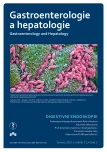Difficult diagnostics and serious biliary complications of liver echinococcosis
Authors:
R. Rosoľanka 1; K. Šimeková 1; Ľ. Laca 2; M. Szilágyiová 1; D. Antolová 3
Authors‘ workplace:
Klinika infektológie a cestovnej medicíny JLF UK a UN Martin, Slovenská republika
1; Chirurgická klinika JLF UK a UN Martin, Slovenská republika
2; Parazitologický ústav, Slovenská akadémia vied, Košice, Slovenská republika
3
Published in:
Gastroent Hepatol 2017; 71(3): 241-244
Category:
Hepatology: Case Report
doi:
https://doi.org/10.14735/amgh2017241
Overview
Echinococcosis is a dangerous parasitic disease that primarily attacks the liver. Several types of echinococci can be distinguished, among which Echinococcus multilocularis causes the alveolar form and is the most dangerous. Other important species of echinococcus include Echinococcus granulosus, which induces the cystic form of echinococcosis, and Echinococcus vogeli and Echinococcus oligarthus, which cause human polycystic echinococcosis. Inoperable or only partially surgically remediable forms of alveolar echinococcosis can occur with complications such as pressure on surrounding structures with eventual overgrowth of parasitic masses into neighboring tissues. Tissue infiltration and dissemination are typical findings in cases of alveococcosis, which can confuse doctors because the etiology is sometimes suggestive of malignant disease. Biliary complications occur in one third of cases and sometimes lead to cholestatic jaundice. Establishing a diagnosis of alveolar echinococcosis is not simple. Four examinations are used in combination: imaging techniques, serological testing, biopsy evaluation, and PCR (polymerase chain reaction). It is helpful to know the epidemiological history of the patient and to possess knowledge of parasite endemicity in different areas. The Slovak Republic, especially its northern regions, is currently considered an endemic area of occurrence. The authors present a case of a patient who, after initial discrepancies in diagnosis, developed complications including biliary oppression with a residual parasitic mass.
Key words:
alveolar echinococcosis – Echinococcus multilocularis – differential diagnosis
The authors declare they have no potential conflicts of interest concerning drugs, products, or services used in the study.
The Editorial Board declares that the manuscript met the ICMJE „uniform requirements“ for biomedical papers.
Submitted:
5. 2. 2017
Accepted:
31. 3. 2017
Sources
1. Eckert J, Gemmell MA, Meslin FX et al. WHO/OIE manual on echinococcosis in humans and animals: a public health problem of global concern. Paris: World Organisation for Animal Health 2001: 100–142.
2. Li T, Ito A, Nakaya K et al. Species identification of human echinococcosis using histopathology. Trans R Soc Trop Med Hyg 2008; 102 (6): 585–590. doi: 10.1016/j.trstmh.2008.02.019.
3. Xiao N, Qiu J, Nakao M et al. Echinococcus shiquicus n. sp., a taeniid cestode from Tibetan fox and plateau pika in China. Int J Parasitol 2005; 35 (6): 693–701.
4. Šváb J, Feyereisl J, Ružička P et al. Echinokoková nákaza – echinococcosis. Čas Lék Čes 2006; 145 (1): 55–58.
5. Deplazes P, Rinaldi L, Alvarez Rojas CA et al. Global distribution of alveolar and cystic echinococcosis. Adv Parasitol 2017; 95: 315–493. doi: 10.1016/bs.apar.2016.11.001.
6. Wen H, Yang WG. Public health importance of cystic echinococcosis in China. Acta Trop 1997; 67 (1–2): 133–145.
7. Sadjjadi SM. Present situation of echinococcosis in the Middle East and Arabic North Africa. Parasitol Int 2006; 55 Suppl: S197–S202.
8. Rossi P, Tamarozzi F, Galati F et al. The first meeting of the European Register of Cystic Echinococcosis (ERCE). Parasit Vectors 2016; 9: 243. doi: 10.1186/s13071-016-1532-3.
9. Antolová D, Miterpáková M, Škútová M et al. Echinococcus multilocularis na Slovensku – aktuálna situácia. Infovet 2015; 21 (6): 245–249.
10. Antolová D, Miterpáková M, Radoňák J et al. Alveolar echinococcosis in a highly endemic area of Northern Slovakia between 2000 and 2013. Euro Surveill 2014; 19 (34): 20882.
11. Kinčeková J, Dubinský P, Dvorožňáková E et al. Diagnostika a výskyt alveolárnej echinokokózy na Slovensku. Čes Slov Gastroent Hepatol 2005; 59 (1): 11–16.
12. Kern P. Clinical features and treatment of alveolar echinococcosis. Curr Opin Infect Dis 2010; 23 (5): 505–512. doi: 10.1097/QCO.0b013e32833d7516.
13. Szilágyiová M, Laca Ľ, Antolová D et al. Importance of complex diagnostic approach in differential diagnosis of alveolar echinococcosis. Helminthologia 2015; 52 (4): 298–302. doi: 10.1515/helmin-2015-0047.
14. Vuitton DA, Bresson-Hadni S. Alveolar echinococcosis: evaluation of therapeutic strategies. Expert Opin Orphan Drugs 2014; 2 (1): 67–86.
15. Vuitton DA. New trends in the treatment of echinococcosis. Helmithologia 1999; 36 (3): 167–170.
16. Horton RJ. Albendazole in treatment of human cystic echinococcosis: 12 years of experience. Acta Trop 1997; 64 (1–2): 79–93.
17. Dubinský P, Bober J, Kinčeková J. Diagnostika a liečba cystickej echinokokózy. Bratisl Lek Listy 1998; 99 (11): 584–586.
18. Koch S, Bresson-Hadni S, Miguet JP et al. Experience of liver transplantation for incurable alveolar echinococcosis: a 45-case European collaborative report. Transplantation 2003; 75 (6): 856–863.
Labels
Paediatric gastroenterology Gastroenterology and hepatology SurgeryArticle was published in
Gastroenterology and Hepatology

2017 Issue 3
Most read in this issue
- Rifaximin
- Guidelines of the IBD working group of the Slovak Gastroenterology Society on the management of ulcerative colitis
- Colonic decompression in daily practice
- Difficult diagnostics and serious biliary complications of liver echinococcosis
